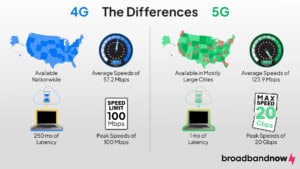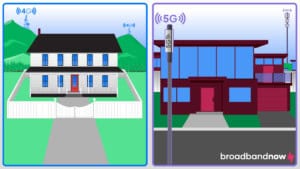Is 4G Obsolete? 4G vs. 5G
5G may be the new standard of wireless internet, but 4G still has its uses, especially if you need online backup.

- 4G technology has been available for 15 years, and experts consider 2030 to be the year we’ll begin phasing it out.
- 2G and 3G networks remained viable solutions for over 20 years each.
- 5G offers new benefits, such as enhanced speed, latency and security features, that are convincing reasons to upgrade.
When a new phone becomes available, the previous version doesn’t immediately become obsolete. Not everyone will have the funds or the interest to purchase a new phone right when it rolls out, just as every city won’t immediately have the full benefits of a new network technology. Before you jump into 5G completely, read our research below to understand the life cycle of 4G, the benefits and drawbacks of 5G and why both networks can coexist for some time in the future.
Overview of 4G
- What Is 4G?
- When Will 4G No Longer Be Available?
- What Are the Differences Between 4G and 5G?
- Can I Use 4G the Same Way I Expect to Use 5G?
- What About 4G LTE?
- What Determines When a Technology Becomes Obsolete?
- How Do I Determine Which Option Is Best for Me?
What Is 4G?
4G, or Fourth Generation, is a version of cellular network technology introduced around the end of 2008. 4G introduced more internet-based networks, as opposed to the previously utilized physical circuit-switching phone networks operated by humans. 4G brought a lower latency, or data lag, meaning connected devices would receive quicker responses to their requests. These upgrades also meant users would see an improvement in the clarity of their voice calls over digital networks and faster speeds for downloading content and loading webpages.
4G also made streaming an HD movie on your phone or playing online video games on the go possible — if not normal. Before 4G, these activities weren’t a possibility at all. Simply put, 4G made utilizing mobile devices for everyday tasks faster and easier than its predecessors.
4G is still widely available, especially in smaller towns and rural areas. It’s also significantly less expensive at the moment than 5G technology. Offering speeds up to 100 Mbps, it remains a fast-paced and accessible network option.
When Will 4G No Longer Be Available?
Suppose we’re using past trends to help us identify when 4G will no longer be available. In that case, we’re around a decade away from seeing 4G being completely outdated and inaccessible, at the minimum. Many experts say that 4G should be available well into 2030, so even though you may see 5G utilized more prevalently, especially in large cities, there’s no reason to believe that 4G is becoming more scarce. Many users may already have 5G connectivity, but manufacturers are building these networks to work in conjunction with 4G networks, not to replace them.
It’s also worth noting that when 4G first became available, it wasn’t nearly as strong as it is today. 4G download speeds at the onset were around 12.5 Mbps, whereas today’s 4G speeds are upward of 57.2 Mbps, on average.
The Life Cycle of a G (Generation)
Historically, we’ve seen networks become obsolete 20 or more years after their introduction. Since 4G first became available in 2009, that would give us until 2029 or 2030, at the earliest, to continue using this network. For a look back at the discontinuation of various cellular standards, check out the following table for reference:
| Name | Release date | Discontinued date |
|---|---|---|
| 2G | 1991 | Between 2017 and 2022 (31 years) |
| 3G | 2001 | 2022 (21 years) |
| 4G | 2009 | N/A |
| 5G | 2020 | N/A |
What Are the Differences Between 4G and 5G?

It’s all about speed, and 5G, or Fifth Generation, wins that race without hesitation. 5G download speeds can reach up to 20 Gbps — essentially 200 times faster than 4G. However, that speed is the fastest possible, not necessarily the average most users will experience. To put this into perspective, you could expect to download a movie in just 49 seconds with 5G instead of 50 minutes with 4G (depending on the movie).
5G differs from all previous cellular networks due to its cloud-based infrastructure. Its network functions primarily through software rather than hardware. You may hear the term “network slicing,” which means that the owner of any slice can tailor its speed, capacity, coverage, encryption and security to its unique requirements.
Latency is also a key difference between 4G and 5G. Latency is the delay between the sending of information and the corresponding response. 4G has an average latency of 200 milliseconds, whereas the 5G latency rate is just 1 millisecond.
5G connectivity also provides more security features, including ensuring that devices meet authentication, confidentiality, storage, and privacy requirements. 5G varies from previous network upgrades in that it’s more about speed, but it also offers new opportunities for enhanced security.
| 4G | 5G |
|---|---|
|
|
Can I Use 4G the Same Way I Can Expect to Use 5G?
Current 4G users can expect to use 5G the same way they use their current devices. Devices won’t need to change significantly to adopt 5G capabilities, and your routine won’t be interrupted or shaken. It’s still unknown when 4G will officially face discontinuation because cell phones using 5G technology will still be using 4G technology for many years.
You can expect 5G to provide faster speeds and lower lapse time, which is a positive side effect. On the inside, 5G transmitters are unique in that they can share frequencies without messing up other transmissions. They also coordinate so users can utilize multiple frequencies simultaneously to fit more data through them.
Since 4G will probably be available for at least another decade, it’s also worth noting that using it may cost significantly less than a 5G upgrade. Certain features may only be possible with 5G, but it’s important to factor in cost when determining which technology is best for you.
What About 4G LTE?
LTE, also known as Long-Term Evolution, was a moniker used to define a 4G network on its way to reaching that standard. Essentially, 4G LTE is the less effective variant of 4G. Even today, many users wrongly assume LTE networks are faster or newer than 4G, but this isn’t the case. While 4G LTE delivers lower speed than the 4G standard, it still exists in many areas. Understanding 4G LTE capabilities will also help users realize that 5G E actually means that a network is working toward an evolution to 5G standards, versus the preconceived notion that 5G E is better than 5G.
What Determines When a Technology Becomes Obsolete?
Technology becomes obsolete when it’s no longer a viable connectivity option. Even if other technology has surpassed its features or capabilities, if the previous generation is still available, that doesn’t mean it’s obsolete. For example, many networks have only completely sunset 3G within the last 2-3 years. That means that 3G didn’t become truly obsolete until that time. However, many users have been utilizing 4G for almost a decade, so it’s all about perspective, location and accessibility.
Should I Switch to 5G?

As we speak, mobile carriers in the U.S. are still rolling out 5G networks. With those rollouts come faster speeds, lower latency, and increased security requirements. 5G is expected to have a much larger network capacity, ensuring it’s available to even more people by standardizing network processes globally and improving overall performance and efficiency.
In short, just like every technology or device upgrade, upgrading has significant benefits. While there’s no rush to trade in your current 4G device or network compatibility, 5G will soon be the way of the future. It may be best to monitor connectivity options in your area and only switch to 5G once you’re confident you’ll have access to the full range of capabilities this network promises users.
About 98 percent of Americans have access to Extended Range 5G coverage, but rural residents don’t all have access to the full-spectrum of 5G service offered in suburban and urban areas. In fact, some rural areas have 5G adoption rates as low as 10 percent. While some of this can be attributed to infrastructure and expansion, some people still have concerns about health, air travel and the impact of 5G in general.
How Do I Determine Which Option Is Best for Me?
When determining which network is best for you, we recommend considering accessibility, cost and security. For now, 4G isn’t going anywhere, and for some people, it’s still the better option. Like many upgrades, the upgrade to 5G will take time. 5G is still inaccessible in many areas, especially rural ones, and it’s still being tested and optimized. While security and speed features may be in place, some still have concerns with the upgraded network.
Since your existing device allows for 4G compatibility, we believe you don’t need to rush to upgrade or alter your current lifestyle just because of new technology options. Do your research, understand the cost benefits or drawbacks and determine which technology is best for you before upgrading to 5G.
Frequently Asked Questions About 4G
Is it okay to still use 4G?
The 4G network is still a reliable option for mobile connectivity, supporting activities such as streaming videos, browsing the internet, using apps and making calls. While 5G offers faster speeds and lower latency, 4G remains the backbone of mobile communication globally and is sufficient for most daily tasks. Many devices on the market still operate exclusively on 4G, and mobile providers are maintaining 4G infrastructure alongside 5G rollouts to ensure coverage for areas where 5G is unavailable. As of now, there’s no rush to upgrade unless you specifically need the enhanced capabilities of 5G.
Is 4G being phased out in the U.S.?
4G is not being phased out in the U.S. anytime soon, but it’s anticipated to phase out starting in 2030. Mobile carriers like Verizon, AT&T and T-Mobile, have committed to maintaining their 4G networks for years to come, even as they expand their 5G infrastructure. 4G LTE will remain a critical component of mobile connectivity to ensure that anyone who relies on 4G devices or live in areas without 5G coverage can continue accessing reliable service. 4G and 5G are expected to coexist for the foreseeable future, with 4G likely supporting connectivity needs into the next decade.
Is 6G a thing?
While 6G is not a reality yet, research and development are underway to make it the next generation of wireless technology. Industry experts anticipate that 6G will begin rolling out around 2030, aiming to offer speeds up to 100 times faster than 5G and even lower latency. The technology is still in its conceptual phase, with researchers exploring new frequencies and infrastructure to support its implementation. For now, 5G remains the cutting-edge standard for mobile networks.
Can you refuse 5G?
You can choose not to use 5G if you prefer. If your device is 4G-only, it will automatically connect to 4G networks, bypassing 5G entirely. Even if you own a 5G-capable device, most smartphones and mobile plans allow you to disable 5G in the settings and use 4G instead. Some people opt for this due to concerns about battery life, data usage, or personal preferences. It’s worth noting that 5G technology is safe and designed to coexist seamlessly with 4G infrastructure.
Is 4G safer than 5G?
Both 4G and 5G meet industry standards for safety. However, 5G includes stronger built-in security features, like better encryption and authentication, which can help protect your data.
Why do some people still prefer 4G over 5G?
Some users prefer 4G because it’s cheaper, more reliable in rural areas and consumes less battery. For everyday tasks like streaming or browsing, 4G speeds are often more than enough.